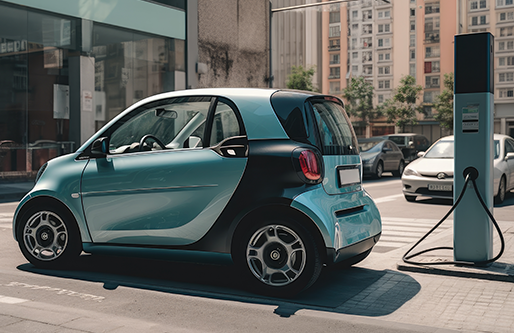Modified on
Ultracapacitors and Fuel Cell Hybridization

Skill-Lync
Continuing our series of articles on fuel cells and ultracapacitors for EV, this short article gives a quick rundown on the basics of ultracapacitors. You will also learn about fuel cell hybridization and the high-level components of software needed to develop fuel cell systems.
The Basics of Ultracapacitors
An ultracapacitor can charge and discharge in microseconds and milliseconds. The rapid charge discharge makes it very efficient when it comes to harvesting regenerative energy and supplying peak power. The ultracapacitor can immediately provide the power and strength required during hard and fast acceleration.
That is why it finds usage in features like stop-start and regenerative braking. There are over 2 million vehicles on the road right now that have stop-start developed by the continental automotive, and they have Maxwell ultracapacitors in them.
The mechanism for storing energy in ultracapacitors is fundamentally different from batteries. Batteries have a chemical reaction occurring inside them through which they conduct electricity. Ultracapacitors, on the other hand, have two terminals and an insulator that separates them.
The positive terminal attracts the negative ions from the electrolyte. As such, ultracapacitors have a much higher power density than the battery because of the terminals storing charge.
Hybridization of Fuel Cell Vehicles

We have seen how the fuel cell works and learned about the ins and outs of ultracapacitors. Together, these two things find use in the hybridization of fuel cells. One of the disadvantages of a fuel cell is the sluggish dynamic response.
Imagine if your vehicle was propelled solely by the fuel cell. If you were to stop at a traffic light and then want to accelerate, then the fuel cell will not be able to provide enough power for rapid acceleration. That is where hybridization becomes crucial.
You must have some energy storage devices in combination with a fuel cell. The permutations and combinations include:
- A fuel cell with an ultracapacitor
- A fuel cell with a battery
- A fuel cell with an ultracapacitor and battery, thereby creating a triple power source
The motor - the essential driving component - is involved in all three cases.
Developing Software Systems for a Fuel Cell Vehicle
When developing systems for a vehicle fuel cell, there are 4 high-level components of the software. Firstly, you pen down the requirements and build the software based on the requisites.
1. Fault Reaction
The fault reaction component of the software monitors any fault. For example, consider a situation where the hydrogen supply is low or the voltage is plummeting.
Based on the data, one needs to decide things like what should be the action? Should you open contactors? Should you limit the amount of current going out from the battery? This way, you classify faults and develop protocols to manage when those faults arise.
2. High Voltage Circuit Monitoring
Via this software component, you will monitor the voltage of the battery, the fuel cell stack overall, and even the individual cells. The role of this software component is to ensure that the voltage never goes too high or too low.
The reason is simple: Extreme voltages can damage components, resulting in malfunctions and loss of valuable time and money. Therefore, high-voltage circuit monitoring plays a vital function.

3. Torque Control and Management
When you press the pedal, a vehicle moves forward essentially by torque on the wheels because an electric motor is driving the wheels. The current has to come from some component to roll the wheels. A torque control strategy ensures that the current is delivered to the motor.
Why is such a software component needed? Many other components, like the 12V battery and DTDC, are requesting current. The job of the torque control and management feature is to ensure adequate current distribution for efficient functioning.
4. Energy Management
The fuel cell is one of the energy-producing components. Then you have a battery and ultracapacitor, and they all store energy. The energy management component ensures that there is always enough energy in the battery. If the energy in the 12V battery is low, the fuel cell will produce more extra power to charge a 12V battery.
Similarly, if the energy high voltage battery falls, the fuel cell produces more current to charge the battery. The energy management software component helps in executing all such balancing.
Case Studies
1. Peak Power Shaving in FCHEV With Integrated UC Energy Management Strategy
A triple-source hybrid topology consisting of a fuel cell, ultracapacitor, and battery is complex. Regarding production vehicles, it becomes unviable due to its cost, packaging, energy management, and functional safety. But it makes for an intriguing R&D and academic topic.
These components are complex to manage, and the more you add, the more complex the power train becomes.
2. Energy Management
The fuel cell has a particular operation range that is most fuel-efficient. Other power sources in the vehicle can supply power when it's difficult to operate the fuel cell in that region, that is, low and high power demand. Energy management is all about managing this available energy on board and harvesting regenerative energy.
Energy management software's job is to ensure that you try to operate in the optimum region. For example, when you request current, you ensure it falls within 40-60% of the power rating. The source of power needs to switch based on the power demand.
However, when you go into regenerative braking, it becomes a bit complex. Because you have two components that can harvest that regenerative energy, you need to develop an algorithm to ensure you keep both of them charged. In such a way, the battery and ultracapacitor harvest the energy very efficiently.
Fuel Cells: A Growing Industry
The field of fuel cells is rich, and the industry is growing. Developing expertise in the field can lead to a rewarding career. By learning about fuel cells and ultracapacitors for EVs, you can take advantage of the many job opportunities emerging in this field.
Register for one of the many courses offered by Skill-Lync and get on the path to success today!
Author
Navin Baskar
Author

Skill-Lync
Subscribe to Our Free Newsletter

Continue Reading
Related Blogs
The average vehicle body gives any vehicle its structural integrity, while the electric motor is concerned with the generation of torque or force. The electric motor can be a permanent magnet synchronous motor, brushless dc motor etc.
24 Aug 2022
In industrial control applications, a PID controller is a device that regulates temperature, flow, pressure, speed, and other process variables. PID (proportional integral derivative) controllers, which use a control loop feedback mechanism to control process variables, are the most accurate and trustworthy controllers.
26 Aug 2022
A lithium-ion (Li-ion) battery is a complicated battery technology that uses lithium ions as a key component of its electrochemistry. During a discharge cycle, lithium atoms within the anode are ionized and separated from their electrons.
28 Aug 2022
Dash in your car is your source of information. It basically functions as a control panel that sits in front of the driver and shows numerous controls and instrumentation required for your car to function.
31 Aug 2022
A hybrid vehicle has two power sources for motion within the same vehicle. Basically the hybrid vehicle is split into two types supported the source for propulsion - combustion engine type and Hydrogen power cell.
06 Sep 2022
Author

Skill-Lync
Subscribe to Our Free Newsletter

Continue Reading
Related Blogs
The average vehicle body gives any vehicle its structural integrity, while the electric motor is concerned with the generation of torque or force. The electric motor can be a permanent magnet synchronous motor, brushless dc motor etc.
24 Aug 2022
In industrial control applications, a PID controller is a device that regulates temperature, flow, pressure, speed, and other process variables. PID (proportional integral derivative) controllers, which use a control loop feedback mechanism to control process variables, are the most accurate and trustworthy controllers.
26 Aug 2022
A lithium-ion (Li-ion) battery is a complicated battery technology that uses lithium ions as a key component of its electrochemistry. During a discharge cycle, lithium atoms within the anode are ionized and separated from their electrons.
28 Aug 2022
Dash in your car is your source of information. It basically functions as a control panel that sits in front of the driver and shows numerous controls and instrumentation required for your car to function.
31 Aug 2022
A hybrid vehicle has two power sources for motion within the same vehicle. Basically the hybrid vehicle is split into two types supported the source for propulsion - combustion engine type and Hydrogen power cell.
06 Sep 2022
Related Courses
